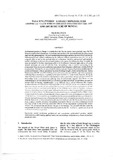'Pala sculptures': A highly sophisticated aesthetic taste which greatly influenced the art and architecture of Bengal
Abstract
Architectural practice in Bengal is notable from the Muslim period, more precisely since the Pre-Mughal as well as the Sultanate era, the architectural practice in this land started with the influences of many stylistic interpretations. The glorious historical monuments and sites are amazed and spectacular with unparallel and brilliant craftsmanship, the influence of those innovations were directed by the religious belief as well as the spiritual sense of acclamation. 'Architectural practice' professionally
started with the association of arts and performance in the spaces for offering the deity. To create the space as desired for the deity became powerful with the alliance of dramatic light, scheme of colour textural eminence and over all with the 'Arty surroundings'. Arty or artistic surrounding is the arrangement where deities are transformed into a piece of art. Religious architecture is dull in absent of sculptural arts. This intellect is correct both for interior and outer facades of practicing architecture, the
ancient architecture is the co-operational balance of putting thoughts of arts and architecture. During Pala dynasty (781-821 and 821-61) Bengal's art and architecture was full bloomed with the gorgeous craftsmanship by two heroes, According to the account of the the Tibetan Lama Taranath1, during the reign of Devapala there flourished two famous artists-Dhiman and his son Bitopal who produced many
outstanding works in sculpture and painting form for architectural majesty. This father and son partnership gave rise two distinct schools of Art which had many followers2. It is probable that many art centers were functioning simultaneously in the different region of the extensive Pala Empire. Sculptures became (he inherent elements in practice of architecture. A large number of stone sculptures discovered throughout Bengal were perhaps the creation of artists from different schools; it is notable that those sculptures were perhaps embedded on the different monasteries or Buddhist structures.
Stone has always been a precious material in Bengal and therefore, when Bengal and Bihar came under one rule during the Pala period, the access to the nearest stone quarry in Rajmahal hills o f Bihar became much easier to the Bengal and the availability of stone ensured the creation o f a school of artists to work in this materials. The research focus is to address the Pala sculptures and the architecture o f those days
were the soul and integrated part of practice, professional and connotation respected the architecture with the form of art, a brick terracotta facade was accomplished with the illustration of the brilliant stone sculptures. And the movement was entirely motivated in Bengal-an ancient architecture when it was bom to built it was obviously associated with the artistic cooperation- a practice that became unique, rich, and spectacular and became the part of the Heritage. The research will also endow the components of artistic activities that determined and cherish the wisdom of spatial excellence of
particular architecture in practice.

